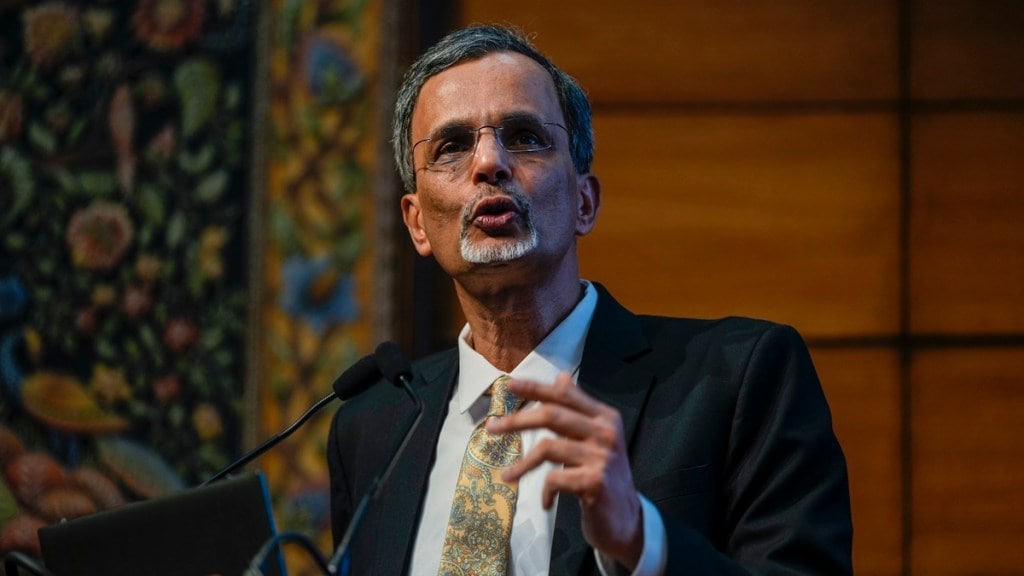Budget 2025: Ahead of the Budget 2025, the pre-budget Economic Survey highlighted that people who rarely consume ultra-processed or packaged junk food have better mental well-being than those who regularly do so.
It also stated that those who rarely exercise, spend their free time on social media or are not close to their families have worse mental health. The survey report tabled in Parliament underscored that if India’s economic ambitions are to be met, then immediate attention must be given to lifestyle choices that are often made during childhood or youth.
Furthermore, hostile work cultures and excessive hours spent working at the desk can adversely affect mental well-being and ultimately put the brakes on the pace of economic growth, the economic survey said citing the study done by the Sapien Labs Centre for Human Brain and Mind.
The survey noted that spending long hours at one’s desk is detrimental to mental well-being and individuals who spend 12 or more hours daily at a desk have distressed or struggling levels of mental well-being. Citing the study, the survey said better lifestyle choices, workplace cultures and family relationships are associated with two-three fewer days lost per month at work. Having poor relationships with managers and low (worst) pride and purpose at work are associated with the largest increases in the number of days one is unable to work, the survey stated.
“The increase in mental health issues in children and adolescents is often linked to the overuse of the Internet and, specifically, social media,” the report said highlighting that while interventions at the government level are being contemplated, there is an urgent need for school and family-level interventions to encourage healthy pastimes such as meeting with friends and playing outside.
It advocated investing time in building close family bonds while stating that it would go a long way towards keeping children and adolescents away from the Internet and improving mental well-being.
‘Impose higher GST and stricter labelling norms on ultra-processed foods’
The pre-budget document tabled in Parliament on Friday said that the government must focus on a multi-pronged approach with stricter FSSAI labelling norms, higher GST, and awareness campaigns to curb consumption of ultra processed foods (UPFs).
“A multi-pronged approach would be required to address the concerns emerging from the increased inclusion of UPFs in diets in India,” it said. Misleading nutrition claims and information on UPFs need to be tackled and should be brought under the scanner, it said.
The Food Safety and Standards Authority of India (FSSAI) could consider bringing UPFs under regulation with a clear definition and standards, including stricter labelling requirements. The Ministry of Health and Family Welfare should urgently define nutrient thresholds for sugars, salt, and saturated fats to regulate advertising, adopt warning front-of-pack labels (FOPL), and impose stricter marketing restrictions on unhealthy foods, especially targeting children under 18.
A 22-country study established that self-regulation has not been very effective in this regard, its said, calling for improved monitoring of branded products to ensure compliance would help build consumer confidence.
It also suggested strengthening consumer protection efforts to deal with aggressive marketing and distribution practices and misleading nutrition claims in advertising, especially when they are targeted towards children and youth.
“A higher tax rate for UPFs may also be considered a ‘health tax’ measure targeted specifically at brands/products that advertise,” it said. There is a need to generate greater awareness around the adverse impact of the consumption of UPFs through campaigns targeted at schools and colleges alongside existing health and lifestyle campaigns of the governments.
According to the survey, efforts also need to be directed to promote local and seasonal fruits and vegetables and facilitate positive subsidies for healthy foods such as whole foods, millet, fruits, and vegetables to improve their availability, affordability, and consumption.
High GST rates and amendments to consumer protection laws could deter misleading advertising. Additionally, a coalition of civil society and government entities, free from conflicts of interest, is vital to educate the public and counter food industry interference.
Standardisation of sugar, salt content on packaged food
The Economic Survey 2024-25 also called upon the Union Health Ministry to “urgently” define nutrient thresholds for sugars, salt, and saturated fats to regulate advertising. It also urged the central ministry to adopt warning front-of-pack labels (FOPL), and impose stricter marketing restrictions on unhealthy foods, especially targeting children under-18.
Dwelling on the impact of ultra-processed food (UPFs) on physical health, the survey tabled in Parliament stressed that making consumers conscious about what they eat, its ingredients and associated side-effects is important to maintain a healthy lifestyle.
Understanding the ingredients of packaged food, the ill-effects of UPF, and healthy food choices should be a part of the school curriculum, it underscored. The report emphasised that called for setting standards for permissible levels of salt and sugar and ensuring checks for UPF brands to adhere to the regulations.
According to the survey, schools, hospitals, and public areas should eliminate UPFs, while incentives should promote affordable healthy food production, it said. High goods and service tax rates and amendments to consumer protection laws could deter misleading advertising, the report recommended.
Additionally, a coalition of civil society and government entities, free from conflicts of interest, is vital to educate the public and counter food industry interference, it stressed. Reducing excess calorie intake and improving dietary quality may help prevent many primary and secondary cardiovascular events, said the economic survey.
“Since UPF brands often target children and adolescents, massive awareness of the potential risk factors of UPF is of utmost necessity. Generating health-conscious consumers can further motivate and incentivise various UPF brands to come up with healthy alternatives or minimise the extent of the negative effects of the UPFs,” it said.
The report called for an “enormous” behaviour change campaigns and efforts to promote local and seasonal fruits and vegetables and subsidies for healthy foods such as whole foods, millet, fruits, and vegetables. The survey said that from sweetened breakfast cereals, soft drinks, and energy drinks to fried chicken and packaged cookies, UPFs have undeniably marked their formidable presence in everyday life.
These foods are generally energy-rich with high levels of sugar, salt and unsaturated fats and are nutrient-deficient as they are made from ingredients derived from a limited variety of crops such as wheat or soy, the report claimed.
The National Dietary Guideline 2024 identifies UPFs as food and beverage products that have undergone extensive industrial processing and contain a high number of additives such as preservatives, sweeteners, emulsifiers, and other substances that are not commonly used in culinary preparations, the survey said. Convenience, hyper-palatability, affordability, longer shelf life and vigorous advertising and marketing strategies have made a conducive environment for the thriving business of UPFs in India, it argued.
The WHO India reports that between 2011 and 2021, the value of retail sales in the UPF segment grew at a CAGR of 13.7 per cent. Though there was a Year-on-year growth rate decline from 12.7 per cent to 5.5 per cent during 2020, the very next year, it was 11.29 per cent, the report stated. According to the Household Consumption Expenditure Survey (HCES) 2022-23, almost 9.6 per cent of the food budget in rural areas and 10.64 per cent in urban areas is spent on beverages, refreshments, and processed food.
“There is enough research to show that the shift in dietary practices from unprocessed to semi-processed and to UPF items exposes an individual to a wide range of adverse health outcomes ranging from obesity, chronic inflammatory disorders, cardiovascular diseases, and mental disorders,” the report said.
Being lower in fibre content, UPFs are observed to lead to weight gain and obesity in adults and children. Studies from across countries show a direct association between exposure to UPFs and 32 health parameters spanning mortality, cancer, and mental, respiratory, cardiovascular, gastrointestinal, and metabolic health outcomes. They also indicate that greater exposure to UPFs leads to anxiety outcomes, mental disorder outcomes, prevalent adverse sleep-related outcomes, heart disease-related mortality, type 2 diabetes, depressive outcomes, wheezing, obesity, and cancer and higher risks of mortality.
There are also evidence that UPFs may hamper immunity and lead to increasing gut impermeability, leading to bacterial imbalance in the gut, the report said. “Increased and frequent consumption of UPF is associated with an increased risk of multimorbidity, which refers to the prevalence of multiple chronic conditions due to non-communicable diseases for an extended period of time,” it stated.
According to WHO, non-communicable diseases, or NCDs, are the reason behind the death of 41 million people each year, equivalent to 74 per cent of all deaths globally, the survey report highlighted. Of all NCD deaths, 77 per cent are in low- and middle-income countries.
The burden of NCD risk factors arises partly from population growth and ageing. According to the 2017 study report ‘India: Health of the Nation’s States’ by the Indian Council of Medical Research (ICMR), the proportion of deaths due to NCDs in India increased from 37.9 per cent in 1990 to 61.8 per cent in 2016.
The four major NCDs are cardiovascular diseases, cancers, chronic respiratory diseases, and diabetes. These diseases share four common behavioural risk factors: unhealthy diet, lack of physical activity, tobacco use, and alcohol consumption, the report stated.
Role of Ayushman Bharat
The survey also highlighted that the Ayushman Bharat health-insurance scheme has played a decisive role in the significant reductions observed in out-of-pocket expenditure through an increase in social security and primary health expenditure, with more than Rs 1.25 lakh crore in savings recorded.
According to the survey, the Ayushman Bharat Pradhan Mantri Jan Arogya Yojana (AB-PMJAY) has revolutionised healthcare by providing a health coverage to the bottom 40 per cent of India’s most vulnerable populations.
It covers more than 12 crore families or, approximately, 55 crore individuals and is the world’s largest health-insurance scheme, offering annual hospitalisation benefits of up to Rs 5 lakh per family for secondary and tertiary care. Launched to address health inequities, the AB-PMJAY prioritises the poorest segments of the population based on the Socio-Economic Caste Census 2011, adopting a holistic and need-based approach, the report said.
It asserted that this initiative aligns with India’s commitment to the sustainable development goals (SDGs), ensuring that no one is left behind. As of January 1 2025, more than 36.36 crore Ayushman cards have been issued, the report said. It added that 30,000 hospitals, including 13,352 private facilities, are empanelled under the scheme. Also, 49 per cent of the cardholders are women and 48 per cent of hospital admissions are utilised by women.
On September 11, 2024, the expansion of the AB-PMJAY was approved to include senior citizens aged 70 and above, irrespective of their socio-economic status. This initiative provides free health coverage of up to Rs 5 lakh per family, benefitting approximately six crore senior citizens across 4.5 crore families, regardless of income, the report said.
The eligible senior citizens will receive a dedicated Vay Vandana Card to access the scheme’s benefits. Additionally, those already covered under the scheme will get an exclusive top-up of Rs 5 lakh annually for their healthcare needs, separate from their family’s coverage.
As of January 15, 2025, more than 40 lakh senior citizens have been enrolled under the scheme, the report said. Other initiatives, such as the free-dialysis scheme, have benefitted around 25 lakh people, it highlighted.
“The reduction in OOPE goes hand in hand with increased public spending in healthcare, demonstrating progress towards universal health coverage,” it stated. The increase in government spending on health has an important implication for the reduction of the financial hardship endured by households.
In the Total Health Expenditure (THE) of the country between Financial Year 2015 and FY 22, the share of government health expenditures (GHEs) has increased from 29 per cent to 48 per cent, the report said.
During the same period, the share of out-of-pocket expenditure (OOPE) in the THE declined from 62.6 per cent to 39.4 per cent, it underlined. The government health insurance schemes constitute a 5.87-per cent share in healthcare-financing schemes, out of which social insurance schemes like the Employees’ State Insurance Corporation (ESIC), Central Government Health Scheme (CGHS) and Ex-Servicemen Contributory Health Scheme (ECHS) have a 3.24-per cent share.
The government-supported voluntary insurance schemes like the AB-PMJAY, Rashtriya Swasthya Bima Yojana (RSBY), state-specific government health-insurance schemes etc. have a 2.63-per cent share in healthcare-financing schemes, the report noted.
Launched in 2018, Ayushman Bharat represents a paradigm shift from selective health services to a comprehensive continuum of care, addressing prevention, promotion and treatment across primary, secondary and tertiary levels. More than 1,75,560 AAMs were operationalised till December 31, 2024.
The Universal Immunisation Programme (UIP) is one of India’s most-impactful public health initiatives, providing life-saving vaccines to millions of newborns and pregnant women annually. Launched as the Expanded Programme on Immunisation in 1978, it was re-branded as the UIP in 1985, extending the coverage from urban to rural areas to bridge healthcare disparities. Currently, the UIP offers 11 vaccines free of cost, protecting against 12 vaccine-preventable diseases.
With full immunisation coverage for FY 24 at 93.5 per cent nationally, the UIP continues to safeguard public health and ensure equitable access to essential vaccines, the report stated. The Jan Aushadhi scheme, launched to provide affordable medicines, has gained significant momentum, achieving record sales in 2024 and expanding to more than 14,000 kendras nationwide.
“Despite challenges like quality concerns, supply issues and thin profit margins for pharmacists, the scheme has improved access to low-cost drugs. Awareness campaigns, expanded product offerings like sanitary napkins and increased rural outreach have boosted its impact, particularly for low-income groups and those with chronic illnesses,” the report highlighted.
“While profitability remains a hurdle for pharmacists and suppliers, the growing demand by consumers highlights the enduring need for affordable healthcare solutions,” it added. While the government’s health initiatives play a crucial role in improving access to healthcare and ultimately, enhancing health outcomes in the country, the overall health of a population is also affected by other socio-economic factors, the report pointed out. These factors include sanitation, education, nutrition, early child development and personal habits, it said.
Role of U-WIN
The U-WIN portal has registered 7.44 crore beneficiaries, conducted 1.26 crore vaccination sessions, and recorded 27.84 crore doses administered as of November 27, 2024, stated the Economic Survey 2024-25 while highlighted that it marks a transformative step in India’s immunisation efforts.
The pre-budget survey tabled in the Parliament on Friday mentioned the initiatives that saw technology integration in healthcare delivery for timely diagnoses and recommendations of personalised treatments to telehealth technologies that connect patients and health professionals in a virtual space to improve efficiency and effectiveness.
The report described U-WIN as a user-friendly platform that enables seamless access to immunisation records, flexible scheduling, ‘anytime access’, and ‘anywhere’ vaccination. Beneficiaries can self-register via the web portal or mobile app, track schedules, and receive SMS reminders for upcoming doses. U-WIN also generates QR-based e-vaccination certificates and facilitates the creation of Ayushman Bharat Health Accounts (ABHA) for parents and children, supporting holistic digital health management.
The portal is accessible in 11 regional languages. Over 1.7 crore pregnant women and 5.4 crore children have been registered digitally and more than 26.4 crore vaccine doses tracked in real-time, the survey stated. The report also said that e-Sanjeevani — the national telemedicine service — has emerged as the world’s largest telemedicine implementation in primary healthcare.
As on November 12, 2024, it has served over 31.19 crore patients through 1.29 lakh Ayushman Arogya Mandir as spokes, which are served by 16,447 hubs and 676 online OPDs with support of more than 22,5,286 doctors, medical specialists, super-specialists and health workers. The integration and use of technology have the potential to offer viable solutions to problems of quality, accessibility and affordability, the report underlined.
“One such example is the potential to prevent loss of lives and save time by leveraging drones for the delivery of medicines in difficult geographies and in times of emergencies,” it highlighted.
Drones are transforming healthcare in India by ensuring rapid delivery of life-saving medicines and collecting samples from remote and inaccessible areas, proving indispensable during emergencies. The project ‘i-DRONE’ (ICMR’s Drone Response and Outreach for North East) was launched under the aegis of the Ministry of Health and Family Welfare in October 2021 to assess the feasibility of using drones to deliver vaccines and medical supplies.
Innovation in Pharmaceutical industry
The survey also said that there is a need to focus on innovation, new drug development and biopharmaceuticals as spending on research and development still lags behind global leaders.
The total annual turnover of pharmaceuticals in FY24 stood at Rs 4.17 lakh crore, growing at an average rate of 10.1 per cent in the last five years. Exports accounted for 50 per cent of the total turnover, with its value at Rs 2.19 lakh crore in FY24. The total import of pharmaceuticals was worth Rs 58,440.4 crore.
“The overall pharma landscape of India points towards a need to focus on innovation, new drug development and biopharmaceuticals, as R&D spending still lags behind global leaders,” the survey said.
The government has taken various measures to support the sector like PLI scheme and Strengthening of Pharmaceuticals Industry (SPI) among others, it noted. PLI scheme aims to attain self-reliance and reduce import dependence in critical Key Starting Materials (KSMs)/Drug Intermediates and Active Pharmaceutical Ingredients (APIs), the survey said.
Elaborating on other steps taken by the government, the survey stated that in October 2023, the Central Drugs Standard Control Organisation approved India’s first indigenously developed CAR-T cell therapy.
To expedite the availability of newer drugs, such as gene therapy products, orphan drugs, drugs representing significant therapeutic advantage, in the country, the Central Drugs Standard Control Organisation has notified the US, UK, Japan, Australia, Canada and the European Union, enabling waiver of local clinical trial for new drugs that are already approved and marketed in the notified countries.
According to the survey, India’s economy is projected to grow between 6.3 per cent and 6.8 per cent in FY26, according to the Economic Survey 2024-25. The survey highlights that the country’s economic fundamentals remain strong, supported by a stable external account, fiscal consolidation, and private consumption.






